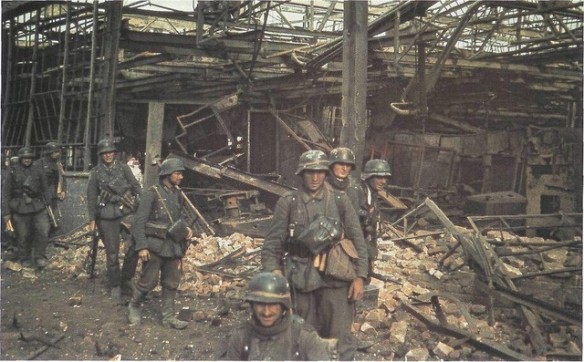
Verdun was chosen quite deliberately to act as a theater-level slaughterhouse. But it is easy enough to find considerable towns or cities in history that were enlisted, so to speak, for a strategic or operational purpose, not because they had any intrinsic quality worth defending to the last soldier.
Stalingrad was one such place. The Second World War battle that now epitomizes the modern siege was fought over a city that was certainly no crown jewel in anyone’s empire. The battle lasted from the end of August 1942, until the end of January 1943, and before it was over, Stalingrad and its immediate surroundings would attract well over a million soldiers, fighting for or against the city, or, perhaps in the end, fighting only for their own survival.
Stalingrad was also unplanned. One could not say that it was selected as an element in a broad strategic and operational scheme by one national military staffer the other. It was not. When the Germans and the Russians began their calculations for the summer campaigning season, neither assigned much military importance to this Volga River town. The major question facing the German High Command was where on the vast Eastern Front the army’s main effort should be fixed. As for the Russians, the major problem was how to combat what the Germans finally decided, for in the early summer of 1942, the Germans still had the strategic and operational initiative on the Eastern Front.
And that is how the summer began: the German armies resumed their offensives in May and rapidly created a new geography of the front. Retreating elements of the Soviet army and advance elements of the German army drew toward Stalingrad. By July, Stalingrad had come to be visualized as the anchor of two German army groups swinging south-eastward for the Caucasus. For the Russians, Stalingrad had become the center of a line of national defense stretching from the Baltic to the Black Sea.
Much was made, then and later, of Stalingrad’s “central position,” as if centrality itself conferred some positive military value upon a place. A central point also divides parts, and in this case, that is what happened on both sides. For the Germans, Stalingrad lay on the seam between Sixth Army and Fourth Panzer Army. Two Russian armies likewise divided—literally—at Stalingrad: the 62d Army held everything in the sector north of the Tsaritsa gorge, while the 64th held everything south of it. Stalingrad’s “central position” belongs in the same category as the “guards the gate to the steppes” argument or “guards the Volga River line” argument. Cities no longer were capable of guarding river lines or steppes or anything else under conditions of modern industrial war. Not even themselves.
Eventually both nations and their leaders convinced themselves that Stalingrad was a place of paramount importance. The Russians were not going to give up the city, whatever the cost, and the Germans were resolved to take it from them, whatever the cost. All summer long, forces seemed to converge upon Stalingrad as if drawn by a magnet. The more Hitler was disappointed by the slow progress of his forces toward the Caucasus, the more he fixated upon Stalingrad. Success here could compensate for shortcomings elsewhere. Stalin—for his part, equally intransigent—made withdrawal from Stalingrad tantamount to a crime against the Soviet state.
If Stalingrad had no intrinsic strategic or operational value as a place neither contributing to nor detracting from strategic or operational objectives—one might well ask what the armies were doing there in the first place, fighting a form of war so far removed from the doctrines these armies had imagined for themselves. One can only note the result: few places if any concentrated as many combatant forces in such close proximity to one another as at Stalingrad. One way or another, the city had become an excellent place for the killing of large numbers of the enemy, and both sides saw the potential value of the situation.
The commitment to fight a outrance at Stalingrad had been made by both sides by the end of July. That done, the city seemed to promise another advantage to the combatants: it attracted and fixed in place units that would not otherwise be there. Both the Germans and the Russians came round to the idea, at different times, that Stalingrad could serve as a pivot on which to maneuver huge offensive operations. Hitler saw this possibility during the early summer, when he was apportioning forces for the coming offensives. The Russians came to the idea later, when it was clear that the Germans’ operational maneuverability was impaired by the commitment they had made at Stalingrad. Then the Stavka planned several operations, one of them the successful Operation Uranus, that actually did the work of victory by cutting off the Sixth Army and trapping it in a pocket.
The city was long and narrow, befitting its location: its population of 500,000 spread itself almost thirty miles along the western bank of the Volga, but edges of the city were rarely more than 4,000-meters wide and sometimes as narrow as 1,500 meters. Only three terrain features of any significance were noted on the tactical maps: the river bank, which was high enough in places to afford some protection for troops just landed; the river Tsaritsa, which bisected the city; and the Mamayet Kurgan, an old Tartar burial mount some 102-meters high. In the southern half of the city, only a massive concrete grain elevator stood out.
The city possessed other, special tactical attributes, not the sort usually noted on standard military maps. Strung out, one after another, for five miles north from Mamayet Kurgan were four massive factories and their surrounding complexes. The first of these was the Lazure Chemical Plant. Slightly north of that came the Red October metal works, which was followed in turn by the Barrikady weapons plant and, finally, the Stalingrad Tractor Factory, which had long been converted to tank production.